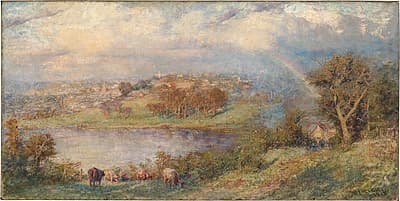Frederick
MCCUBBIN
Australia
1855
–
1917
Flood waters
[Rainbow over the Yarra]
1913
oil on canvas
signed and dated, l.r., "F. McCubbin 1913"
92.5 (h)
x 182.0 (w)
cm
Purchased 1973
National Gallery of Australia, Canberra
NGA 1973.532
When Flood waters was first exhibited in May 1913, reviewers praised it for not being a faithful reproduction of nature. The occasion was the first annual exhibition of the Australian Art Association. The Argus provided (or reported) an aim for the recently formed Association: ‘The time has arrived when conventional, precise, and mechanical reproductions of nature should be excluded by selection committees. The great want in most Australian art of to-day is a personal message, musical quality of line and colour, and that genuine feeling which appeals to all natures.’ An illustration of this was ‘Mr. McCubbin’s luxuriant landscape “Flood Waters”, retaining a good deal of the liquid warmth of the old masters’ (Argus, 7 May 1913, p 5). Another review noted that: ‘Mr. McCubbin’s Flood Waters, broad in conception and tender in feeling, is a poetic rendering of evening light’ (Age, 7 May 1913, p 11).
McCubbin took considerable liberties with this landscape, which is nonetheless still recognisable. The foreground and flooded middle distance shows the ‘Como’ estate which adjoined the artist’s house and grounds from the east of Kensington Road, South Yarra, looking towards the river. Kathleen Mangan recalled that many cows grazed at ‘Como’. The Yarra River regularly flooded the lower parts of ‘Como’ until the river was re-routed. At the rainbow’s end to the right of the picture is the gardener’s cottage which appears in Moonrise (cat 20) and The cottage children (Rain and sunshine) (cat 37). In the interests of a unified, rhythmic composition the artist reversed the slope of the land in the foreground: in reality the land sloped downward left to right, and the cottage was tucked under the hill.
Flood waters resembles certain 1830s paintings by John Constable—for example, Hampstead Heath with a rainbow 1836 (Tate; then in the NGL). Both works show a landscape spread wide and described in generous curves, a rainbow, accents of trees and buildings, and a dramatic chiaroscuro. (McCubbin owned a book about Constable, his daughter said and drew a few sketches in blank pages at the back.)
Turner is present too, in the big sky, the vast landscape and the atmospheric, opalescent colours. McCubbin’s students at the National Gallery’s school had given him Turner’s golden vision by C Lewis Hind (1910). McCubbin kept this book in his studio, open at colour reproductions of paintings of which he was particularly fond.
Mary Eagle
